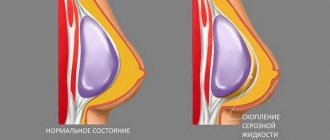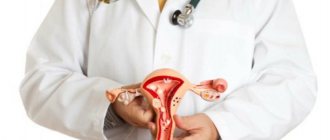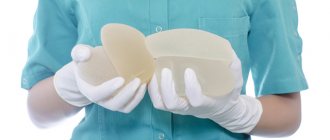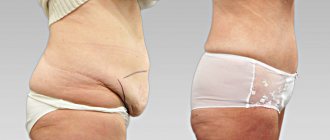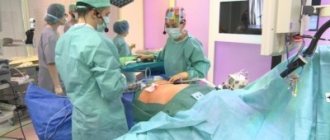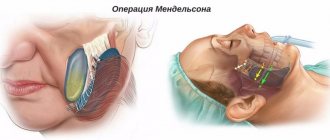Serous fluid appears in the human body as a result of natural processes in the body. It looks like straw-colored moisture. The viscosity level of this exudate depends on the balance of fractions that are formed during the filtration process of the liquid in the blood vessels.
Serous fluid consists of two fractions: liquid and formed elements. The latter includes protein, leukocytes, mesothelium and other elements.
Excess serous fluid in the human body appears in cases where there is a malfunction in the functioning of the circulatory and lymphatic systems. This condition is most often observed after any surgical intervention. It is called seroma .
What is it - postoperative suture seroma?
We all know that many surgeons perform “miracles” in the operating room, literally bringing a person back from the other world. But, unfortunately, not all doctors conscientiously perform their actions during the operation. There are cases when they forget cotton swabs in the patient’s body and do not fully ensure sterility. As a result, in the operated person, the suture becomes inflamed, begins to fester or separate.
However, there are situations where problems with a stitch have nothing to do with medical negligence. That is, even if 100% sterility is observed during the operation, the patient suddenly accumulates liquid in the incision area that looks like ichor, or pus of a not very thick consistency. In such cases, they speak of seroma of the postoperative suture. What it is, in a nutshell, can be said this way: it is the formation of a cavity in the subcutaneous tissue in which serous effusion accumulates. Its consistency can vary from liquid to viscous, the color is usually straw-yellow, sometimes supplemented with blood streaks.
Classification of postoperative hernias
Hernial protrusions are classified by size. Highlight:
- a small postoperative hernia,
which is located in any one area of the abdomen and does not change its configuration. Determined only by palpation or ultrasound examination with the size of the hernial orifice up to 5 cm; - medium postoperative hernias
, which occupy part of one area of the abdomen with the formation of a visible protrusion and the size of the hernial orifice from 5 to 10 cm; - large postoperative hernias,
completely occupying any area of the anterior abdominal wall, changing the shape of the abdomen, with the size of the gate from 10 to 15 cm; - giant postoperative hernias
, occupying two or three areas of the abdomen or more, sharply deforming the abdomen, interfering with everyday life, with the size of the hernial orifice more than 15 cm. In 2006, the Society of Herniologists of Russia recommended adhering to the SWR Classification, recognized in Madrid at the XXI International Congress herniologists.
This classification takes into account three main parameters: the localization of the hernia in relation to the navel (median, lateral and combined), the size of the hernia orifice and the presence of relapses.
At-risk groups
Theoretically, seroma can occur after any violation of the integrity of lymph vessels, which do not “know how” to thrombose quickly, as blood vessels do. While they are healing, lymph continues to move through them for some time, flowing from the rupture sites into the resulting cavity. According to the ICD 10 classification system, seroma of the postoperative suture does not have a separate code. It is assigned depending on the type of operation performed and the reason that influenced the development of this complication. In practice, it most often occurs after such cardinal surgical interventions:
- abdominal plastic surgery;
- cesarean section (this postoperative suture seroma has ICD 10 code “O 86.0”, which means suppuration of the postoperative wound and/or infiltration in its area);
- mastectomy.
As you can see, it is mainly women who are at risk, and those who have solid subcutaneous fat deposits. Why is that? Because these deposits, when their integral structure is damaged, tend to peel off from the muscle layer. As a result, subcutaneous cavities are formed, in which fluid begins to collect from the lymph vessels torn during the operation.
The following patients are also at risk:
- those suffering from diabetes;
- elderly people (especially overweight);
- hypertensive patients.
Causes
To better understand what it is - postoperative suture seroma, you need to know why it forms. The main causes do not depend on the competence of the surgeon, but are a consequence of the body’s reaction to surgical intervention. These reasons are:
- Fat deposits. This has already been mentioned, but we will add that in overly obese people whose body fat is 50 mm or more, seroma appears in almost 100% of cases. Therefore, doctors, if the patient has time, recommend liposuction before the main operation.
- Large wound surface area. In such cases, too many lymph vessels are damaged, which, accordingly, release a lot of fluid and take longer to heal.
Treatment of pathology
Serous fluid under the surgical suture may persist for a long time, but in most cases it disappears by 20 days after surgery. The timing of disappearance strongly depends on the nature of the surgical intervention, its complexity and the area of the wound surface. All this time, the doctor must closely monitor the development of seroma.
Treatment of pathology begins if there is too much moisture under the skin and there is a serious risk of developing an inflammatory process or sepsis. The essence of treatment is to remove exudate from under the skin. This is done in various ways.
Vacuum aspiration
This method of treating seroma is used most often. It allows you to get rid of exudate in the early stages of the development of pathology that is not complicated by the inflammatory process.
The doctor makes a small incision in the area where moisture accumulates, into which a suction tube is inserted. After turning on the vacuum device, the moisture accumulated under the skin is mechanically removed.
Using the vacuum aspiration method can significantly speed up the healing of a postoperative wound. In addition, after the procedure, patients note a significant improvement in their well-being.
The main disadvantage of this technique is possible relapses. The fact is that vacuum aspiration only removes exudate, but does not eliminate the cause of its appearance. For this reason, after vacuum aspiration, doctors begin to eliminate the factors influencing the appearance of serous exudate under the postoperative suture.
Subcutaneous drainage
This is a surgical method for treating seroma of a postoperative scar. Its main difference from the vacuum aspiration method is that the doctor does not use special equipment.
Drainage involves removing serous fluid by gravity. To do this, a puncture is made in the area where exudate accumulates, through which a drainage system is inserted under the skin. Its outer part is connected to a collection of withdrawn biological material. After this, the exudate will be drained from under the skin immediately after its appearance.
Increased tissue trauma
It was mentioned above that seroma of the postoperative suture depends little on the conscientiousness of the surgeon. But this complication directly depends on the skills of the surgeon and on the quality of his surgical instruments. The reason why seroma can occur is very simple: the work with the tissues was carried out too traumatically.
What does it mean? An experienced surgeon, when performing an operation, works with damaged tissues delicately, does not squeeze them unnecessarily with tweezers or clamps, does not grab them, does not twist them, and performs the incision quickly, in one precise movement. Of course, such jewelry work largely depends on the quality of the instrument. An inexperienced surgeon can create a so-called vinaigrette effect on the wound surface, which unnecessarily injures the tissue. In such cases, the ICD 10 code for seroma of the postoperative suture can be assigned as follows: “T 80”. This means “a complication of surgery not noted elsewhere in the classification system.”
Excessive electrocoagulation
This is another reason that causes suture gray after surgery and to some extent depends on the competence of the doctor. What is coagulation in medical practice? This is a surgical procedure performed not with a classic scalpel, but with a special coagulator that produces a high-frequency electric current. In essence, this is a targeted cauterization of blood vessels and/or cells by current. Coagulation is most often used in cosmetology. She has also proven herself excellent in surgery. But if it is performed by a physician without experience, he may incorrectly calculate the required amount of current or burn excess tissue. In this case, they undergo necrosis, and neighboring tissues become inflamed with the formation of exudate. In these cases, seroma of the postoperative suture is also assigned the code “T 80” in ICD 10, but in practice such complications are recorded very rarely.
Prevention of seroma
It goes without saying that it is better not to treat seroma, but to first carry out preventive actions that help avoid its occurrence. There are several preventive methods .
- The wounds are carefully sutured so that there are no pockets through which infection can enter and lead to inflammatory processes.
- After the surgical procedure, you need to place a small weight on the wound. For such purposes, ordinary sandbags are most often used.
- Many doctors recommend using accordion drainage.
- During plastic surgery, various surgical measures are carried out in order to increase the immunity of the damaged area to infection.
- It is recommended to continuously use antiseptics or antibiotics during treatment. Typically, antibiotics are used immediately after surgery, and then the doctor prescribes them as needed.
Clinical manifestations of seroma of small sutures
If the surgical intervention was on a small area of skin, and the suture turned out to be small (accordingly, the doctor’s traumatic manipulations affected a small volume of tissue), the seroma, as a rule, does not manifest itself in any way. In medical practice, there are cases where patients did not even suspect it, but such a formation was discovered during instrumental studies. Only in isolated cases does a small seroma cause minor pain.
How to treat it and is it necessary to do it? The decision is made by the attending physician. If he deems it necessary, he may prescribe anti-inflammatory and painkillers. Also, for faster wound healing, the doctor may prescribe a number of physiotherapeutic procedures.
Survey
Detecting a hernia is usually not difficult. Most often, a visual inspection and palpation of the protrusion is enough. If necessary, an ultrasound examination is performed.
However, when preparing for surgical treatment, it is necessary to conduct a full examination in order to identify and timely correct concomitant diseases that may become risk factors for hernia recurrence. And also evaluate the function of the respiratory and cardiovascular systems in order to choose the most suitable method of operation for each patient.
If difficulties arise in diagnosis - in case of complex multi-chamber hernias, when it is necessary to determine the topography of the hernia defect, measure the hernial orifice for individual selection of a mesh implant - an MRI of the abdominal organs is performed.
Clinical manifestations of seroma of large sutures
If the surgical intervention affected a large volume of the patient’s tissue or the suture was too large (the wound surface is extensive), the occurrence of seroma in patients is accompanied by a number of unpleasant sensations:
- redness of the skin in the suture area;
- nagging pain that gets worse when standing;
- during operations in the abdominal region, pain in the lower abdomen;
- swelling, bulging of part of the abdomen;
- temperature increase.
In addition, suppuration of both large and small seromas of the postoperative suture may occur. Treatment in such cases is very serious, including surgical intervention.
Diagnostics
We have already discussed why seroma of a postoperative suture can occur and what it is. Treatment methods for seroma, which we will consider below, largely depend on the stage of its development. In order not to start the process, this complication must be detected in time, which is especially important if it does not announce itself in any way. Diagnostics is carried out using the following methods:
Examination by the attending physician. After surgery, the doctor is required to examine his patient's wound daily. If undesirable skin reactions are detected (redness, swelling, suppuration of the suture), palpation is performed. If there is a seroma, the doctor should feel fluctuation (flow of liquid substrate) under the fingers.
Ultrasound. This analysis perfectly shows whether or not there is accumulation of liquid in the seam area.
In rare cases, a puncture is taken from the seroma to clarify the qualitative composition of the exudate and decide on further actions.
Why does fluid ooze from the suture after surgery?
In medicine, this fluid is called seroma. It is mainly a liquid containing protein and lymphocytes. Many believe that this is lymph, or a breakdown product of blood, that is, plasma. It is clear, odorless water with a yellowish tint. It mainly forms on large scars, due to the fact that there is extensive damage to the capillaries and lymph nodes.
Why does fluid ooze from the suture after surgery?
- Swelling, redness, and hyperthermia appear in the area of accumulation of serous tissue. Accordingly, if the scar after surgery is red, swollen, and hot, this means that fluid is accumulating in it. The fluid itself is not dangerous, but it can delay the recovery process after surgery. Often, the sutures, due to the accumulation of a large amount of serous fluid, are cut again and cleaned to remove it.
- Accordingly, in many clinics, after extensive interventions in the suture area, tubes are left in place, that is, drainages that allow the accumulated fluid to escape. This allows you to avoid swelling, redness, and complications after surgery. This fluid usually accumulates 3 days after surgery.
- That is, if the suture is very large and extensive intervention was performed, then on the third day you can notice swelling and hyperthermia of the suture. This does not mean that there will necessarily be a complication. The fluid usually goes away 14-21 days after surgery.
- That is, three weeks after the intervention, there should be no swelling or moisture in the suture area. Accordingly, if the seam gets wet, it is necessary to resort to measures that prevent infection from entering the wound.
The seam
Conservative treatment
This type of therapy is most often practiced. In this case, patients are prescribed:
- antibiotics (to prevent possible further suppuration);
- anti-inflammatory medications (they relieve inflammation of the skin around the suture and reduce the amount of fluid released into the resulting subcutaneous cavity).
Nonsteroidal drugs such as Naproxen, Ketoprofen, and Meloxicam are more often prescribed.
In some cases, the doctor may prescribe steroidal anti-inflammatory drugs, such as Kenalog, Diprospan, which block inflammation as much as possible and accelerate healing.
Surgery
According to indications, including the size of the seroma and the nature of its manifestation, surgical treatment may be prescribed. It includes:
1. Punctures. In this case, the doctor removes the contents of the resulting cavity with a syringe. The positive aspects of such manipulations are as follows:
- can be performed on an outpatient basis;
- painlessness of the procedure.
The disadvantage is that the puncture will have to be done more than once, and not even twice, but up to 7 times. In some cases, it is necessary to perform up to 15 punctures before the tissue structure is restored.
2. Installation of drainage. This method is used for seromas that are too large in area. When drainage is placed, patients are simultaneously prescribed antibiotics.
Treatment of seroma
In case of seroma formation after surgery, it is necessary to carry out a differentiated approach to its treatment. In all cases, broad-spectrum antibiotics and anti-inflammatory drugs are prescribed. If the seroma is small, then it is possible to limit it to its removal without removing the implant. In case of persistent accumulation of fluid, it is necessary to rinse the implantation pocket with an antiseptic and install drainage. In a situation where all measures for the treatment of seroma do not lead to a positive effect within several days, the implant will most likely have to be removed. You can return to repeat surgery after 3-6 months.
| The incidence of seroma after tibia augmentation is 0.1-0.5%. The effectiveness of timely treatment is very high and in the vast majority of cases leads to a quick and complete cure. |
More complications of cruroplasty
Folk remedies
It is important to know that regardless of the reasons for the seroma of the postoperative suture, this complication is not treated with folk remedies.
But at home, you can perform a number of actions that promote healing of the suture and prevent suppuration. These include:
- lubricating the seam with antiseptic agents that do not contain alcohol (“Fukorcin”, “Betadine”);
- application of ointments (Levosin, Vulnuzan, Kontraktubeks and others);
- inclusion of vitamins in the diet.
If suppuration appears in the suture area, you need to treat it with antiseptic and alcohol-containing agents, for example, iodine. In addition, in these cases, antibiotics and anti-inflammatory drugs are prescribed.
In order to speed up the healing of stitches, traditional medicine recommends making compresses with an alcohol tincture of larkspur. Only the roots of this herb are suitable for its preparation. They are washed well from the soil, crushed in a meat grinder, put in a jar and filled with vodka. The tincture is ready for use after 15 days. For a compress, you need to dilute it with water 1:1 so that the skin does not get burned.
There are many folk remedies for healing wounds and scars after surgery. Among them are sea buckthorn oil, rosehip oil, mumiyo, beeswax, melted with olive oil. These products should be applied to gauze and applied to the scar or seam.
If the suture gets wet after surgery, what should I do?
Often the seams become wet after breast augmentation or reduction surgery or plastic surgery to correct the shape. The fact is that there are lymph nodes in the armpits, and the breasts are very close to them. That is why all the lymph that is formed in these nodes is directed to the incision area. In this area, the risk of developing seroma is approximately 15%. It increases in case of excess weight, high blood pressure and diabetes.
If the suture gets wet after surgery, what to do:
- Please note that there is no cause for concern if the liquid is yellow, transparent, straw-colored and does not have an unpleasant odor. If a large amount of blood is released in the suture area, the liquid is quite thick and has an unpleasant odor, you should definitely consult a doctor.
- It is possible that a secondary infection has developed in the suture area, which is fraught with the accumulation of pus and the occurrence of sepsis. Therefore, it is better to go to the doctor one more time than to sacrifice your own health.
- Many mothers, after a cesarean section, complain that there is no one to leave the child with or that the baby is breastfed and constantly hangs on the chest. In this case, it is recommended to express the milk, leave the baby with the grandmother or husband, and go to the maternity hospital. Within 30 days after birth, a woman in labor has the right to go to the maternity hospital to assess the condition of the sutures.
Abdominoplasty
Usually after surgery, the doctor leaves drains in the scar area for several days so that the fluid flows out and does not accumulate and cause swelling. The fact is that the presence of a large amount of fluid can cause tissue deformation, and the whole point of the operation will come to naught.
Postoperative suture seroma after cesarean section
Complications in women whose obstetrics were performed by caesarean section are common. One of the reasons for this phenomenon is the mother’s body, weakened by pregnancy, which is unable to ensure rapid regeneration of damaged tissues. In addition to seroma, a ligature fistula or keloid scar may occur, and in the worst case scenario, suppuration of the suture or sepsis. Seroma in women giving birth after a cesarean section is characterized by the fact that a small dense ball with exudate (lymph) inside appears on the suture. The reason for this is damaged blood vessels at the site of the incision. As a rule, it does not cause concern. Seroma of postoperative suture after cesarean does not require treatment.
The only thing a woman can do at home is to treat the scar with rosehip or sea buckthorn oil to speed up its healing.
The suture gets wet after surgery, how to treat it?
Doctors recommend proper care of the postoperative suture. Many people ignore advice on purchasing compression garments, bras and panties. This should not be done, because underwear allows you not only to reduce the belly after a caesarean section, but also prevents the development of seroma. Pressure is necessary on the suture area to prevent fluid accumulation.
The suture gets wet after surgery, how to treat it?
- It is often recommended to ventilate the seam after a caesarean section. You should not cover it with a large number of bandages, much less seal it with adhesive tape. Such manipulations provoke a sauna effect, as a result of which the seam sweats, possibly causing a secondary infection.
- Therefore, in between wearing compression garments, it is recommended to walk without clothes, or at least with a T-shirt raised, so that the seam dries out and is ventilated. In addition, it is recommended to wash the wound with laundry soap twice a day. This product dries the skin well and disinfects it. It is recommended to carry out antiseptic treatment using hydrogen peroxide or regular alcohol.
- Some experts recommend Solcoseryl or Bepanten ointment. But Bepanten is oil-based, so it can also provoke an infection, this is important if it is already very hot outside. You should definitely follow the doctor’s recommendations and not lift anything heavy.
- After all, this can also contribute to the seam coming apart and getting wet. Usually after 2-3 weeks the suture is completely tightened and heals without traces. The wound stops getting wet. Often one or two holes may be found on the surface of the seam. These are peculiar fistulas through which excess fluid comes out. There is nothing wrong with their formation, however, keloid scars and the proliferation of fibrous tissue may appear. This may subsequently cause seals to form.
Abdominoplasty
Complications
Postoperative suture seroma does not always go away on its own and not in everyone. In many cases, without a course of therapy, it can fester. This complication can be provoked by chronic diseases (for example, tonsillitis or sinusitis), in which pathogenic microorganisms penetrate through the lymph vessels into the cavity formed after surgery. And the liquid that collects there is an ideal substrate for their reproduction.
Another unpleasant consequence of seroma, which was not paid attention to, is that the subcutaneous fatty tissue does not fuse with the muscle tissue, that is, the cavity is constantly present. This leads to abnormal skin mobility and tissue deformation. In such cases, repeated surgery must be used.
Factors contributing to the appearance of seroma
The risk of serous exudate in the postoperative area increases under the influence of certain factors. These include:
- Rough work of a surgeon. During the operation he damaged too much tissue.
- Postoperative inflammation. Each person's tissues react differently to traumatic effects. In some people they recover very quickly. Others may develop post-operative inflammation, accompanied by the release of fluid from the lymphatic vessels.
- Excess weight. According to statistics, postoperative scar seroma is detected in 75% of overweight patients.
- Tissue burns. Cells die when exposed to high temperatures. Then their necrosis occurs, accompanied by the release of inflammatory moisture. Such burns can occur if the coagulation apparatus is not used confidently during surgery.
- Diabetes. This disease causes increased glucose levels in the body, which interferes with normal tissue healing.
- Subcutaneous fat tissue is too thick. If its thickness exceeds 5 cm, then with a high degree of probability the patient will encounter seroma. To avoid this complication, doctors have to perform liposuction first. Only after this can surgery on the abdominal cavity be performed.
- Age. The older a person is, the lower the ability of his body’s tissues to recover. This is explained by a significant decrease in the intensity of metabolic processes.
- High blood pressure. Hypertension makes it difficult for blood clots to form in damaged vessels and promotes the development of bleeding.
Prevention
On the part of the medical staff, preventive measures consist of strict adherence to the surgical rules of the operation. Doctors try to perform electrocoagulation more gently and injure less tissue.
On the part of patients, preventive measures should be as follows:
- Do not agree to surgery (unless there is an urgent need) until the thickness of the subcutaneous fat reaches 50 mm or more. This means that you first need to do liposuction, and after 3 months, surgery.
- After surgery, wear high-quality compression stockings.
- Avoid physical activity for at least 3 weeks after surgery.
Seroma after abdominoplasty: causes of development, treatment, prevention
Surgical tummy tuck is a complex and very traumatic procedure. During the operation, a large amount of skin and excess fat are excised, even the muscular aponeurotic layer is affected. Concomitant pathologies in the patient, surgeon errors, non-compliance with the rules of the recovery period - all this can provoke various adverse consequences.
Seroma after abdominoplasty is an accumulation of lymph between the layers of tissue that were surgically exposed during a tummy tuck. Most often, such formation occurs in the area of the sutured edges of the wound - where the scar subsequently forms. The fluid collects in the cavity between the fat layer and damaged capillaries, and can remain there for weeks or months.
Is this situation considered a complication? What factors lead to its development? What symptoms should you pay attention to, how to distinguish them in time and what should you know about treatment? Are there effective prevention measures? All details and verified medical information are available only on TecRussia.ru:
↑ Causes of occurrence
Correction of the anterior abdominal wall during abdominoplasty is always accompanied by rupture or incision of the lymphatic vessels. Unlike blood vessels, they cannot quickly close with a thrombus, so even after the operation is completed and sutures are applied, exudate continues to be released from them. Taking into account the area and location of the postoperative wound, it is almost impossible to provide complete rest to the injured area - with the slightest movements, and even simply during breathing, tissue displacement can occur, which is why even more fluid is released into them. If its outflow is difficult, the appearance of seroma cannot be avoided. Such an unfavorable development of events can lead to:
| Risk factor | What's the point |
| Excessive trauma | During large-scale interventions, the surgeon must carefully separate intact (healthy) tissues from pathological ones. Rough and aggressive work with the wound surface increases the risk of cavities forming in the scar area, in which exudate will inevitably accumulate. |
| High activity of the immune system | Lymph contains leukocytes, which play an important role in protecting our body from infections and other foreign elements, therefore, with any injury, its increased formation and delivery to the emergency zone occurs. Some patients produce fluid in quantities that exceed normal levels, and therefore are more likely to develop seromas. In addition, problems arise with prolonged inflammation in the area of the surgical incision: the longer the healing takes, the higher the risk of serous stagnation. |
| Disorders of the cardiovascular system | Fluctuations in blood pressure, changes in blood lipid balance, and dysfunction of vasomotor reactions provoke uneven distribution of lymph in the surgical area and poor drainage. |
| High body mass index | Statistically, this is one of the most common causes of seroma. It is believed that if the thickness of subcutaneous fat in the abdominal area exceeds 5 cm, problems cannot be avoided. It is even worse if this condition is associated with diabetes mellitus, since it further impairs blood circulation and lymph flow (abdominoplasty is usually contraindicated for such patients). |
| Elderly age | In people over 70 years of age, due to the general aging of the body, regeneration processes worsen, and wound healing occurs more slowly. Also, as a rule, they have certain problems with the cardiovascular system. This means that the occurrence of lymph stagnation is much more likely than in young patients. |
↑ Symptoms and diagnosis
As a rule, seroma occurs in the first 1-2 weeks after tummy tuck. Its size can range from 10-20 ml to 1-2 liters. Diagnosing a small accumulation of fluid at an early stage is difficult due to the lack of external signs and patient complaints. When 0.5 liters or more of lymph accumulates in the wound, a characteristic clinical picture appears:
- limited swelling in the scar area;
- unpleasant sensations – aching and/or pulling, intensifying when moving to a standing position, moderate pain;
- a feeling of transfusion at the site of localization of the serous formation;
- skin hyperemia;
- increase in body temperature to subfebrile levels (37.0-37.5C);
- general weakness, severe fatigue.
During the examination, the surgeon determines additional signs of pathology:
- an increase in the size of the abdomen (most often in its lower part);
- the presence of a symptom of fluctuation, and in rare cases, a visually detectable flow of fluid when changing body position;
- local hyperthermia.
An ultrasound examination is performed to confirm the diagnosis of seroma. During the procedure, healthy tissues of varying density and a cavity with fluid are clearly visible on the monitor. At this stage, it is extremely important to exclude a much more dangerous pathology - an abscess, for which a puncture is carried out and an assessment of the extracted contents is carried out: the serous fluid is light in consistency, has a light yellow color and does not smell of anything, pus is much denser, with a cloudy greenish tint and a characteristic unpleasant smell.
↑ Prospects and forecast
Quite often, seroma resolves on its own, but this process should not be left to chance, especially in the case of abdominoplasty, during which fairly extensive tissue damage occurs. Possible (and not so rare) complications include:
- Seroma suppuration up to the formation of an abscess: pathogenic microorganisms can enter here both from the outside and from any chronic source of infection in the body (carious tooth, sinuses, tonsils). A closed cavity where the contents of lymphatic vessels accumulate is an excellent environment for the proliferation of pathogenic bacteria.
- The proliferation of a layer of cells that secrete mucous exudate and prevent the fusion of the walls of the serous “pocket”. A similar situation occurs if the cavity formation has existed for a long time (years) and further complicates further treatment.
- Changes in the structure of the abdominal wall, thinning of subcutaneous fat, the formation of excessive amounts of scar tissue - this is not dangerous to health and life, but aesthetically it looks unattractive.
↑ What should be the treatment
Immediately after the completion of tummy tuck, the patient is given a drainage system - tubes with a collection of biological material, through which there is a constant outflow of fluid in the first few days. They are removed when the daily volume of released exudate does not exceed 20-30 ml. It is believed that our body “utilizes” this amount naturally without any problems - normally this happens within 2-3 weeks.
In case of further increase in the size of the seroma, deterioration of the general condition, or the appearance of signs of infection, specific therapy is prescribed. Its goal is to improve the outflow of lymph and minimize the size of the cavity in which it accumulates. This treatment is based on the use of antibacterial drugs, the task of which is to prevent infection, reduce the severity of aseptic inflammation and reduce lymph production. For the same purposes, drugs from the NSAID group are often prescribed, incl. Diprospan and Kenalog.
- Possible complications after abdominoplasty and methods of treating them
- Why does swelling appear after tummy tuck and how long does it last?
In case of ineffectiveness of drug therapy or rapid growth of the cavity, vacuum aspiration of the contents of the seroma is performed. To do this, an incision is made with a scalpel at the site of fluid accumulation, through which the excess is pumped out using a special tube. As a result, patients feel noticeably better, and discomfort in the suture area disappears. However, often one such session is not enough and after temporary relief a relapse follows. It may take several weeks to several months of regular aspiration for the lymphatic vessels to completely close and for the walls of the cavity where the fluid has accumulated to shrink and grow with connective tissue.
↑ Prevention of seroma after abdominoplasty
To avoid the appearance of cavities with serous contents, coordinated work between the patient and the surgeon is necessary. The doctor must:
- Before performing abdominoplasty, assess the risks of complications and, if necessary, provide recommendations for their elimination.
- Carefully handle tissues that are affected during the intervention.
- Close the wound layer by layer. The distance between seams should not exceed 1 cm.
- Prescribe antibiotics to prevent inflammatory reactions.
- Install drains in a timely manner.
The patient, in turn, needs to:
- Before performing a surgical tummy tuck, reduce body weight and, if possible, eliminate other risk factors (normalize blood pressure, treat chronic infections, etc.)
- Wear compression garments according to the schedule specified by the doctor, if this is necessary for rapid wound healing and restoration of ability to work.
- Avoid physical activity and lift heavy objects for 1-2 months.
- Visit the surgeon in a timely manner and inform him of any discomfort or other atypical sensations.
Doctors say that seroma is not a disease or a complication, but only features of the lymphatic system in a particular patient. However, remember: ignoring the symptoms and untimely treatment of this condition can lead to unpleasant consequences, including abscess formation with the need for repeated surgery.
